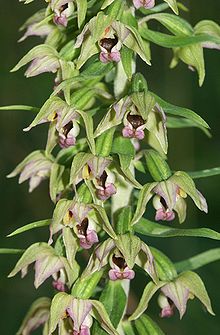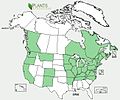Epipactis helleborine
| Epipactis helleborine | |
|---|---|

| |
| Scientific classification | |
| Kingdom: | Plantae |
| Clade: | Tracheophytes |
| Clade: | Angiosperms |
| Clade: | Monocots |
| Order: | Asparagales |
| Family: | Orchidaceae |
| Subfamily: | Epidendroideae |
| Genus: | Epipactis |
| Species: | E. helleborine
|
| Binomial name | |
| Epipactis helleborine | |
| Synonyms[1][2] | |
|
List
| |

Epipactis helleborine, the broad-leaved helleborine, is a terrestrial species of orchid with a broad distribution. It is a long lived herb which varies morphologically with ability to self-pollinate.[3]
Description[]
Epipactis helleborine grows to a maximum height of 92 cm (36 in) and has broad dull green leaves which are strongly ribbed and flat.[4] The flowers are arranged in long drooping racemes with dull green sepals and shorter upper petals. The lower labellum is pale red and is much shorter than the upper petals.[5]
Achlorophyllous, white Epipactis helleborine plants have been found. Achlorophyllous forms tend to be shorter, as small as 17 cm.[4]
Flowering occurs June–September.[6]
Distribution[]
This species is widespread across much of Europe and Asia, from Portugal to China, as well as northern Africa.[1][7][8]
In North America, it is an introduced species and widely naturalized mostly in the Northeastern United States, eastern Canada and the Great Lakes Region, but also in scattered locations in other parts of the continent.[9][10][11] In the US it is sometimes referred to as the "weed orchid" or "weedy orchid" and continues to spread throughout the country to new areas including Michigan,[12] Wisconsin,[13] and the San Francisco Bay Area.[14]

Distribution in North America
Habitat[]
Found in woods and hedge-banks[15] and often not far from paths near human activity.[16] It is one of the most likely European orchids to be found within a city, with many sites for example in Glasgow, London and Moscow. Sometimes spotted beside car parks.[17]
Epipactis helleborine is known for its successful colonization of human-made or anthropogenic habitats such as parks, gardens or roadsides.[18] These roadside orchids exhibit special features such as large plant size and greater ability to produce flowers.[18] Pollination plays a huge role as pollinators such as Syrphidae, Culicidae, Apidae etc. possess greater species diversity and visits the flowering sites more in anthropogenic habitats as compared to native ones.[18] The visitation rates along with the reproductive success of these orchids are higher in large populations as they are more attractive to pollinators.[3]
Ecology[]
This species of orchid is pollinated by several species of Hymenoptera, particularly the common wasp, but also other species in the genera Vespula and Dolichovespula. Flowers release a sweet nectar to attract the wasps, which has an intoxicating effect on them.[19][20] Eight populations of Epipactis helleborine in central Europe (Lower Silesia, Poland) had their nectar studied and they were found to contain naturally occurring oxycodone (as well as another narcotic-like opioid) in minute amounts.[21]
Epipactis helleborine requires a mycorrhizal symbiosis to germinate successfully and remains partially dependent upon the fungus when plants mature, however it is not particularly selective among fungal species. Fungi associated with the live roots include Tuber, Helotiales, Peziza, Leptodontidium, Hydnotrya and Wilcoxina.[22][23]
It has been suggested that the presence of this orchid species in a woodland is an indicator that edible truffles can be found there,[24] but this is not always the case.
Subspecies[]
A rather long list of names have been proposed for subspecies, varieties and forms of Epipactis helleborine, far too many to list here.[25] This is not unusual for such a widespread species. At present (November 2021) only the following are accorded international acceptance:[25]
- Epipactis helleborine subsp. bithynica (Robatsch) Kreutz - Turkey
- Epipactis helleborine subsp. helleborine - widespread
- Epipactis helleborine subsp. neerlandica (Verm.) Buttler - Great Britain, Sweden, Belgium, Netherlands, France, Germany
- Epipactis helleborine var. tangutica (Schltr.) S.C.Chen & G.H.Zhu - China
- Epipactis helleborine subsp. tremolsii (Pau) E.Klein - France, Spain, Portugal, Sardinia, Italy, Algeria, Morocco
References[]
- ^ a b Kew World Checklist of Selected Plant Species, Epipactis helleborine
- ^ Kew World Checklist of Selected Plant Families, Epipactis helleborine subsp. helleborine, synonyms
- ^ a b Ehlers, B. K.; Olesen, J. M.; Ågren, J. (2002). "Floral morphology and reproductive success in the orchid Epipactis helleborine: regional and local across-habitat variation". Plant Systematics and Evolution. 236 (1/2): 19–32. doi:10.1007/s00606-002-0197-x. ISSN 0378-2697. JSTOR 23644960. S2CID 9878820.
- ^ a b General Morphology and Anatomy of Chlorophyll-free and Green Forms of Epipactis helleborine
- ^ Webb, D.A., Parnell, J. and Doogue,D . 1996. An Irish Flora. Dundalgan Press (W. Tempest) Ltd. Dundalk.ISBN 0-85221-131-7
- ^ First Nature - Epipactis Helleborine
- ^ Altervista Flora Italiana, Elleborine comune, Epipactis helleborine (L.) Crantz
- ^ Flora of China v 25 p 180, 火烧兰 huo shao lan, Epipactis helleborine (Linnaeus) Crantz
- ^ Flora of North America v 26 p 586, Epipactis helleborine (Linnaeus) Crantz
- ^ Biota of North America Program, county range map
- ^ "World Checklist of Selected Plant Families".
- ^ "Broad-leaved helleborine: A weedy orchid invading lawns and flowerbeds".
- ^ http://www.nps.gov/plants/alien/pubs/midatlantic/plants-to-watch.htm[bare URL]
- ^ "Epipactis helleborine".
- ^ Clapham, A.R., Tutin, T.G. and Warburg, E.F. 1968. Excursion Flora of the British Isles. Cambridge University Press ISBN 0 521 04656 4
- ^ Beesley, S. and Wild, J. 1997. Urban Flora of Belfast. Institute of Irish Studies and The Queen's University of Belfast. ISBN 0-85389-695 X
- ^ PeerJ - Pollinator diversity and reproductive success of Epipactis helleborine (L.) Crantz (Orchidaceae) in anthropogenic and natural habitats
- ^ a b c Rewicz, Agnieszka; Jaskuła, Radomir; Rewicz, Tomasz; Tończyk, Grzegorz (2017-04-18). "Pollinator diversity and reproductive success of Epipactis helleborine (L.) Crantz (Orchidaceae) in anthropogenic and natural habitats". PeerJ. 5: e3159. doi:10.7717/peerj.3159. ISSN 2167-8359. PMC 5398293. PMID 28439457.
- ^ London Wildlife Trust - Orchid for July
- ^ Bioinfo - Epipactis helleborine
- ^ “Why do pollinators become 'sluggish'? Nectar chemical constituents from Epipactis helleborine L. Crantz Orchidaceae”. Applied Ecology & Environmental Research. 2005;3(2):29-38. Jakubska A, Przado D, Steininger M, Aniol-Kwiatkowska A, Kadej M.
- ^ Annals of Botany - Differences in mycorrhizal communities between Epipactis palustris, E. helleborine and its presumed sister species E. neerlandica
- ^ Mycorrhiza - Epipactis helleborine shows strong mycorrhizal preference towards ectomycorrhizal fungi with contrasting geographic distributions in Japan
- ^ Acta Biologica Szegediensis - Could orchids indicate truffle habitats? Mycorrhizal association between orchids and truffles
- ^ a b Kew World Checklist of Selected Plant Families - List of names for Epipactis helleborine
External links[]
- Epipactis
- Orchids of Asia
- Orchids of Europe
- Plants described in 1753
- Taxa named by Carl Linnaeus

